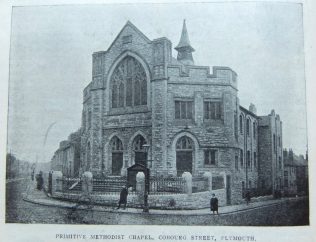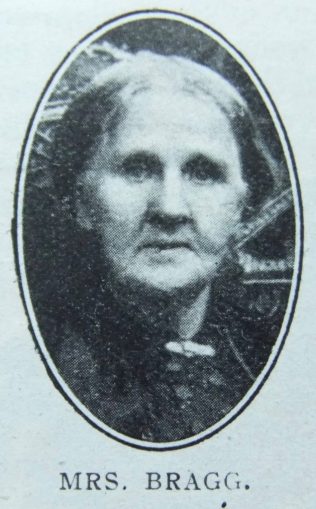Plymouth, Devon









Transcription of Article in the Christian Messenger by Wilson Eccles
The “three towns” of Plymouth, Stonehouse and Devonport, though not amalgamated, form one community of 200,000 people. They are strongly garrisoned; and, in regard to employment of labour, the Government Dockyard is easily of the first importance. Soldiers and blue-jackets are very much in evidence. The ground is historic, the chief hero being Sir Francis Drake. The scenery, both by sea and by land, is charming. The folk are hospitable. Devonshire lanes and Devonshire cream deserve all the good things that have been said about them.
Connexionally, our career has been chequered. Wm. Clowes came here in 1825 and left behind him a society, but unfortunately it did not endure. In 1854 the General Missionary Committee sent Mr. D. Dent, who laboured with such success that in the next year he reported thirty members. We have still some veterans who can remember Thos. Drew, and E. Cook Pritchard who followed. So effectual were the efforts of these and other pioneers, that in 1860 there were reported 295 members in the Circuit, which by that time contained several villages. Ten years later the number was 227; in 1880 it was 210, and in 1890 it only reached 212. Thus there was a quarter of a century which was unprogressive. This must have given rise to many searchings of heart. That it did so, indeed, is shown by the fact that in 1892 the Rev. J. H. Best, whom I remember in the Manchester District as a strong, leading man, then in the prime of life was stationed here, with a distinct purpose to make a forward movement. Like his predecessors, he found many obstacles and much discouragement; so much, that again taking the end of the decade, we find that the membership of the circuit had sunk to two hundred. Mr. Best, however, had set his mind upon one particular object, viz., to supersede Ebrington Street Chapel, Plymouth, with a structure which should be worthy of our Church in a great town.
The Ebrington Street property had been purchased in 1859, and no doubt, at the time, this was a large undertaking and a creditable advance. For nearly half a century this was our headquarters. Here many souls were saved and many Christian workers trained. The memory of the old chapel is precious to numbers of people who were born there; but it was inadequate in a town where all other evangelistic free churches had good properties.
After much patience and more hard work than can be told, the Cobourg Street Church was built. It is a noble structure, occupying a commanding position at the triangular junction of two streets. It is handsome, and well-lighted within and without. It seats comfortably six hundred and eighty people. There is a large schoolroom. There are six other rooms suitable for various purposes. The cost of the premises was over £9,000, and the debt, when finished, £3,160. The opening services took place in February, 1908; and Mr. Best, who had been in Plymouth sixteen years, no doubt hoped to do a great work in the new place. But now “the labourer‘s task is o’er.“ In November of the same year he was taken ill, and passed away in a few days. His death was followed by that of Mrs. Best only three weeks later. She had been throughout a true helpmeet of her devoted husband.
Mr. Best’s ministry in Plymouth was great. He vastly improved our property not only at Coburg Street but at Stoke, Holbeton, and Dunstone also. At his last quarterly meeting the membership was 234. Until the Conference of 1900 the Rev. John Smith took charge of the Circuit and reported 250 members. Then the Rev. D. T. Mann, full of energy and faith, came on the scene. In four years he raised the membership from 250 to 335, the increase being almost entirely at Cobourg Street; and he reduced the debt from £3,160 to £2,690. He inaugurated, and would have completed, a scheme for a new organ, suitable in every way for the new church.
But in July last he was stationed at Letchworth to commence a task even harder than that at Plymouth. The organ was half paid for when the change took place. It is now clear of debt, and once more we are turning our attention to the debt on the church itself. The members are united, and spiritually-minded, generous and hard-working. No doubt there is in store for it a powerful future, which will be an ample justification of a bold and costly Home Missionary policy.
Let us glance round the Circuit. Herbert Street, Morice Town, was the first Connexional chapel to be built, in 1859. It is still in use, and an earnest, hard-working church of eighty members gathers there. Millbridge, Stoke, with fifty-five members, is another good centre of activity. Then there is Keyham Barton Mission, a small society with a large Sunday school, a few devoted workers and a hopeful sphere of labour, but too much debt.
These four churches are in the towns. They comprise a membership of three hundred – 3/20 per cent. of the population. We have about 1,400 sittings, and on Sunday evenings about 550 hearers. Our town property is worth £12,000, and bears a debt of £4,049. We have seven hundred and thirty scholars and sixty-eight teachers in the four Sunday schools, and we have on the same ground twenty-seven local preachers. It is clear that there is great room for improvement, but it is cheering to know that progress is being made.
The three village societies are at Holbeton and Dunstone, in Devonshire, and at Landrake in Cornwall. From Holbeton to Landrake it is twenty miles as the crow flies, and the societies at the two ends of the line are very different in their characteristics. The Cornish people are more demonstrative, more Celtic in their disposition than those of Devonshire. But hospitality is developed to a high degree in all the three villages. The walks are hilly and rather long, but every journey is worth taking, because of the loyalty and love of these friends in the country.
At Landrake there is a very friendly clergyman who likes to entertain our preachers. In the villages we come generally into much closer touch with families than we can in the towns.
Just a word about some of our people. Mr. Edwin Smith is a veteran worker with a youthful heart. He was for many years the Circuit Steward. He retired to a village a few miles away, but soon found that he was much too far from Cobourg Street, and is now happily in town again. Mrs. Phillips, an octogenarian, spent the middle portion of her life in London, where her husband was a police officer.
Many years ago the Rev. Thomas Penrose told her that he had failed to get a suitable place for the Metropolitan Missionary Meeting. Mrs. Phillips said, “Go and ask Mr. Spurgeon for the Metropolitan Tabernacle, and I will pray for you till you come back.” Mr. Penrose hesitated, but was encouraged by remembering that Mr. Spurgeon had been converted in a Primitive Methodist chapel. He went with his request, and returned in triumph.
Mr. and Mrs. Phillips returned to their native Circuit and rendered great service for some years at Dunstone and then in Plymouth. They were the largest donors to the Cobourg Street Church. Mr. Phillips passed away a few years ago; our friend still remains with us, a good and cheerful helper of the work.
Space would fail us to tell of the Fox family, Mr. and Mrs. Stark, the Gerry family, the Trevethicks, the Taylors, and other old and honoured standard-bearers whose names should not be allowed to pass. Then there are Mrs. Bragg, of Morice Town, and others who love to tell of camp meetings of fifty years ago, and recall other evangelistic efforts of a past generation. One man of experience at Landrake told me the other day that one of my gestures reminded him of George Mitchell, who was here in 1858-9.
Coming to the modems, we can point with gratitude to the Rev. W.H. Collins, of Teignmouth, who was brought up here, and who has accepted a call to the African Missions. His mother is one of our most assiduous workers. Nor should we forget Mr. Percy E. Hall, the zealous and wise choirmaster and school superintendent of Cobourg Street; nor Mr. Steed, of Morice Town, who, though he looks so young, must have qualified for a medal as school secretary and choirmaster; nor Mr. Rowlands, who, with his family, is a tower of strength at Stoke. We have two
Councillors—Mr. J.J.H. Moses as a Liberal member of the Devonport Town Council, and Mr. W.J. Squire, of Holbeton, member of the Plympton U.D. Council – would be a credit to any church. May they long be able to continue their public work both as Councillors and as Primitives.
Plymouth ought to become much stronger than it has ever been. The last few years have seen real advancement, and to-day the Circuit is looking forward and eager to do well. Its spiritual condition gives cause for much gratitude. Its difficulties are only financial. “We will triumph in thy salvation, and in the name of our God will we set up our banners.”
In the Revs. H.J. Sadd and T.W. Morgan the Station has found two ministers of worth and ability. To our regret they will both be leaving next July, the former to take up the superintendency of Hitchin Circuit, and the latter, as we hope and believe, to enter the “Approved List.”
This winter we have had the joy of receiving Mrs. Clarke, widow of the late Rev. Geo. Clarke, who was at one time superintendent of this Circuit. Her husband’s name is remembered with pleasure, and we trust she may be spared in health for years to come to exert, as she does, a gracious spiritual influence, helpful to the Master’s work.
Some considerations occur to me in closing. The southern character is less self-reliant than the northern. Not so many aspire to be leaders; they are more content to follow. But the northern character is not more trustworthy than that of the south. Perhaps two reasons operated against our progress here in the past; first, John Wesley made his mark upon this corner of England even more than on most parts; and secondly, the Bible Christians originated here, and their origin and methods were akin to our own, and simultaneous with ours. But we are here now; and we have warm, loyal hearts around us, responsive to appeal and example, and with faith in our future. Then this Circuit shows how well it is for towns and villages to work together. It is in the former that the latter are bound together. Separated by long distances, most of the country members have never seen each other, yet they make one Connexional household. In union they find strength. They benefit the towns by providing outlets for sympathy and energy. Let us resolutely stick to the villages, and let our Circuits grow.
References
Christian Messenger 1914/89





No Comments
Add a comment about this page